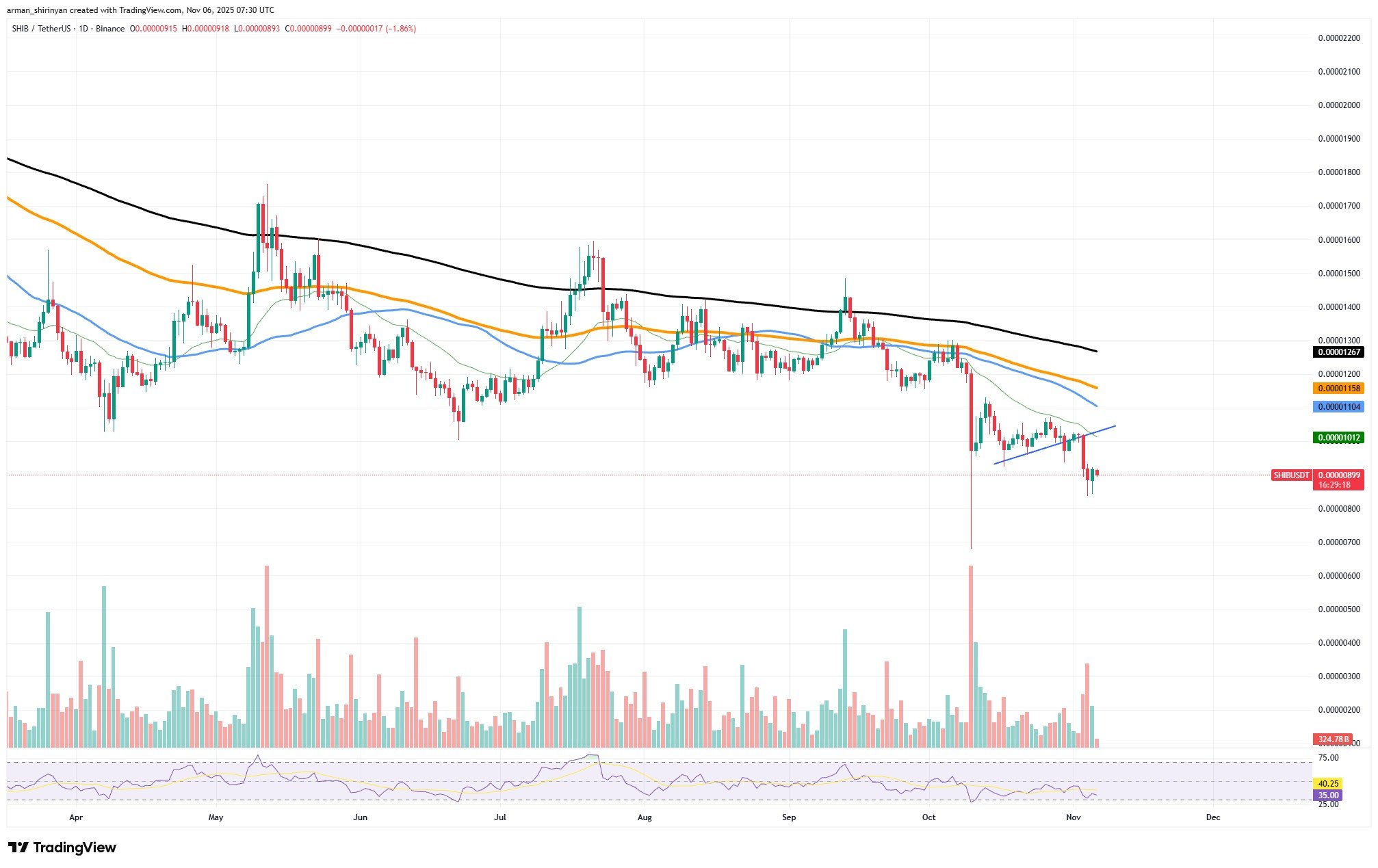The Shiba Inu burn rate surged 674% in the last 24 hours, with over 12 million tokens destroyed, but this increase remains insignificant due to the massive total supply of 589 trillion SHIB. Such sporadic burns fail to meaningfully impact scarcity or price, highlighting the limitations of the current mechanism.
-
Shiba Inu burn rate spikes are common but ineffective: Recent data shows over 12 million SHIB burned in 24 hours, yet this represents a tiny fraction of the circulating supply.
-
The majority of burned tokens stem from a 2021 event by Vitalik Buterin, not ongoing community efforts.
-
Without a structured burning protocol tied to transactions, these burns serve more as symbolic gestures than drivers of value, with SHIB price holding steady at around $0.0000089.
Discover why the Shiba Inu burn rate’s 674% surge is largely meaningless for SHIB investors. Explore the facts on token scarcity and real utility in this in-depth analysis. Stay informed on crypto trends—read now for key insights.
What is the Shiba Inu Burn Rate?
Shiba Inu burn rate refers to the speed at which SHIB tokens are permanently removed from circulation by sending them to inaccessible wallet addresses. In the past 24 hours, this rate jumped 674%, resulting in over 12 million tokens burned, but the total burned supply stands at approximately 410 trillion SHIB, a figure largely unchanged over recent months. This mechanism aims to reduce supply and potentially boost value through increased scarcity, though its impact remains limited given the enormous total supply of around 589 trillion tokens.
The concept of burning tokens is not unique to Shiba Inu; it’s a common strategy in the cryptocurrency space to manage supply dynamics. For Shiba Inu, burns are primarily community-driven, involving voluntary actions rather than automated processes. Blockchain explorers like Etherscan track these activities, showing that daily burns fluctuate significantly but rarely exceed a few million tokens. This recent spike, while headline-grabbing, equates to less than 0.000002% of the total supply, underscoring its negligible effect on overall market dynamics.
Historical context adds depth to understanding the burn rate’s role. In 2021, Ethereum co-founder Vitalik Buterin famously burned over 410 trillion SHIB tokens he received as a donation from the project’s creators. According to public blockchain records, this single event accounts for the vast majority of the burned supply, dwarfing all subsequent community efforts combined. Without such large-scale interventions, the ongoing burn rate struggles to make a dent, as evidenced by the steady price of SHIB around $0.0000089 despite the surge.

SHIB/USDT Chart by TradingView
Why Isn’t the Shiba Inu Burn Rate the Best Mechanism for Value Creation?
The Shiba Inu burn rate lacks a built-in protocol that systematically reduces supply through ecosystem activities, such as transaction fees or staking rewards, making it less effective than mechanisms in projects like Binance Coin (BNB), where quarterly burns are tied directly to trading volume. Data from blockchain analytics platforms indicates that community burns for SHIB are sporadic and meme-driven, with most involving small transfers to null addresses—essentially voluntary donations to the void. This approach, while engaging for the community, does not scale reliably; for instance, the recent 674% increase burned just 12 million tokens, a drop in the ocean compared to the 589 trillion in circulation.
Experts in the crypto space, including those from firms like Messari, have noted that true scarcity requires sustained, utility-based burns rather than hype cycles. A report from crypto research outlet The Block highlights that tokens with deflationary models integrated into core usage—such as Ethereum’s EIP-1559 fee burns—see more consistent price support. For Shiba Inu, the absence of such integration means burn events generate short-term buzz but fail to influence long-term value. Price charts from platforms like TradingView show no upward movement following the spike, with SHIB trading flat at $0.0000089, reinforcing that these burns are more symbolic than substantive.
Furthermore, the community’s reliance on voluntary actions introduces variability and unpredictability. Unlike automated burns in other ecosystems, SHIB’s method depends on individual enthusiasm, which wanes without tangible incentives. Statistics from Shibburn tracker reveal that since the 2021 Buterin burn, monthly averages hover below 1 billion tokens destroyed, far too low to alter supply meaningfully. This inefficiency is compounded by Shiba Inu’s meme-coin origins, where viral marketing often overshadows fundamental improvements. As a result, investors seeking genuine deflationary pressure may look elsewhere, while SHIB holders remain hopeful for future developments like Shibarium layer-2 enhancements that could introduce more robust burning.
In comparison, successful burn mechanisms in the industry demonstrate what SHIB could aspire to. For example, BNB’s burns have removed over 40% of its initial supply through structured programs, correlating with price appreciation. SHIB’s decentralized autonomous organization (DAO) efforts to promote burns via partnerships or NFT integrations have shown promise but remain nascent. Until a shift toward protocol-level burns occurs, the current rate will continue to be viewed as marketing noise rather than a catalyst for growth.
Frequently Asked Questions
What Impact Does the Recent 674% Increase in Shiba Inu Burn Rate Have on SHIB Price?
The 674% surge in Shiba Inu burn rate, destroying over 12 million tokens in 24 hours, has had no noticeable impact on SHIB’s price, which remains around $0.0000089. This is because the burned amount is minuscule relative to the 589 trillion total supply, failing to create meaningful scarcity. Blockchain data confirms such spikes are too small to influence market dynamics without broader adoption.
How Does Shiba Inu Burning Work and Is It Effective for Investors?
Shiba Inu burning works by community members sending tokens to dead-end wallet addresses, permanently removing them from circulation to potentially increase scarcity. While it engages the holder base, it’s not very effective for investors right now because burns are voluntary and small-scale, not tied to daily usage like in some other cryptos. For real value growth, you’d want burns linked to network activity for sustained impact.
Key Takeaways
- Shiba Inu Burn Rate Limitations: Despite a 674% increase, daily burns of 12 million tokens are insignificant against 589 trillion in supply, offering little scarcity boost.
- Historical Dominance: Over 410 trillion burned SHIB traces back to Vitalik Buterin’s 2021 action, making recent efforts pale in comparison and community-driven burns unreliable.
- Path to Improvement: Investors should watch for protocol upgrades like Shibarium that could introduce utility-based burns, turning symbolic gestures into real value drivers.
Conclusion
In summary, while the Shiba Inu burn rate’s recent 674% surge grabs attention, it underscores the limitations of the current mechanism in creating lasting value amid a vast 589 trillion token supply. The Shiba Inu burn rate needs evolution toward structured, activity-linked reductions to become a true bullish force, as seen in more effective models elsewhere. As the crypto market evolves in 2025, SHIB enthusiasts should focus on ecosystem developments for potential price catalysts—consider exploring token utility updates to stay ahead in this dynamic space.
